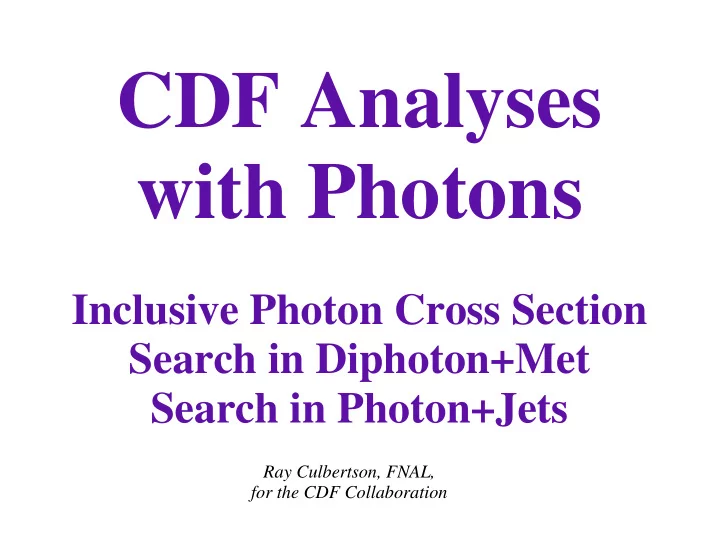

CDF Analyses with Photons Inclusive Photon Cross Section Search in Diphoton+Met Search in Photon+Jets Ray Culbertson, FNAL, for the CDF Collaboration
Inclusive Cross Section Sensitive to ♦ gluon PDF ♦ new physics �������������������������������������������� Complementary to jets ������������������ ������������ !!"������ Pheno 2008 2 Ray Culbertson
Inclusive Cross Section Event Selection ♦ E T >30 GeV, | η |<1 ♦ calorimeter isolation < 2 GeV ♦ efficiency measured in Pythia+GEANT Monte Carlo, checked with data Z → ee Trigger Selection ♦ E T >25 GeV, calorimeter isolation< 10% ♦ efficiency measured using data Z → ee ♦ nearly 100% efficient Pheno 2008 3 Ray Culbertson
Inclusive Cross Section Largest issue: separate backgrounds from jets faking photons γ γ γ γ γ γ γ γ π π � π π jet γ γ γ γ Method: ♦ fit calorimeter isolation shape ♦ templates from Pythia+GEANT Pheno 2008 4 Ray Culbertson
Inclusive Cross Section Photon Fraction ♦ Result of isolation fit ♦ Systematic variations in templates ○ Z data (limited E T range) ○ several other variations ♦ Currently, use a conservative, preliminary 15% systematic uncertainty Pheno 2008 5 Ray Culbertson
Inclusive Cross Section Results ♦ unfolded - corrects for E resolution ♦ 1% E scale uncertainty = 5% on cross section ♦ not corrected for underlying event - additional 10% uncertainty ♦ Compares well to NLO calculation JETPHOX ( JHEP 0205:028,2002 ) ♦ 451 pb -1 ♦ plans: increase to 3 fb -1 , E T range to 300 GeV, reduce systematics Pheno 2008 6 Ray Culbertson
Search for Diphoton and MET Model independent ♦ explore the kinematic distributions, looking for anomalies Complex background mix ♦ True MET ♦ Non-collision ○ W or Z ○ beam halo ○ γ , e → γ , j → γ or τ → γ ○ cosmics ○ data-based prediction ○ data-based prediction ♦ QCD ○ real and fake photons ○ data-based Met resolution model Selection ♦ Targeted cuts ♦ Two photons 2.0 fb -1 ○ beam halo ○ Et > 13 GeV ○ cosmics ○ | η | < 1 ○ e → γ Pheno 2008 7 Ray Culbertson
Search for Diphoton and MET 1) Non-collision Background Cosmics ♦ reduce with ○ no muon stubs (early data) ○ EM in time (later data) ♦ data for counts, MET template Beam Halo ♦ muons travelling with beam ♦ cuts on E along muon path ♦ data for counts, Met template Pheno 2008 8 Ray Culbertson
Search for Diphoton and MET EM-seeded 2) Electroweak backgrounds “Phoenix” rejection ♦ Reject e → γ with “Phoenix” ♦ Remaining e γ events * P(e → γ ) ♦ Correct with MC( γγ )/MC(e γ ) ○ FSR γ , τ → γ ♦ MET template same method γ e det� e� Fake Rate (after phoenix rejection) using E� →� γ� T� 0.05� fake rate� Fake rate in Drell-Yan MC� 0.045� Fake rate parametrization� 0.04� γ� →� 0.035� e� 0.03� 0.025� 0.02� 0.015� 0.01� 0.005� 0� 20� 30� 40� 50� 60� 70� 80� 90� E� , [GeV]� T� Pheno 2008 9 Ray Culbertson
Search for Diphoton and MET 3) QCD – real or fake photons plus jets Test on Z Monte Carlo: MET Model ♦ make MET distribution prediction CDF Run II Preliminary based on observed jets in the event Monte Carlo ♦ jet resolution parameterized MET Model from dijet MC, including tails ♦ validate resolution on data ♦ for each event, smear jets with E T >3 GeV ♦ if E T >15, use jet corrections ♦ include unclustered E resolution ♦ integrate over smearings ♦ define significance, “METSig”: -LOG10( P(MET fluctuation>MET observed) ) Pheno 2008 10 Ray Culbertson
Search for Diphoton and MET Non-collision 0.80 ± 0.27 Signal region results Fake Met 3.0 ± 1.8 METSig>5.0: SM with real MET 41.6 ± 7.0 probability of MET Total 45.4 ± 7.2 fluctuation < 10 -5 Observed 34 Pheno 2008 11 Ray Culbertson
Search for Diphoton and MET Signal region results METSig>3.0 METSig>4.0 METSig>5.0 10 3 10 4 10 5 QCD rejection Efficiency for W γ → e νγ (%) 84 79 72 Pheno 2008 12 Ray Culbertson
Search for Photon and Jets Model Independent ♦ explore the kinematic distributions, looking for anomalies Background mix ♦ Electroweak ♦ Non-collision ♦ QCD (dominant!) ○ W or Z ○ beam halo ○ inclusive photon ○ γ , e → γ , j → γ or τ → γ ○ cosmics ○ jets faking photons Selection ♦ Targeted cuts ♦ >=1 jet ♦ One photon ○ beam halo ○ Corrected ○ E T > 30 GeV ○ cosmics E T >15 ○ | η | < 1 ○ e → γ (Phoenix) ○ | η | < 3 ○ events with isolated tracks Currently only examining 10% of 2 fb -1 (test sample)! Pheno 2008 13 Ray Culbertson
Search for Photon and Jets Two background methods ♦ For kinematic distributions very sensitive to photon E T ○ use Pythia photon Monte Carlo for real photon template ○ use loose photon sample for fake photon template ○ combine using 70% overall inclusive photon fraction ○ normalize total to data total ♦ For kinematic distributions more sensitive to jet configuration ○ use loose photon sample for fake photon template ○ normalize total to data total normalization scheme implies we are only sensitive to shapes, and excesses in the low statistics regions Pheno 2008 14 Ray Culbertson
Search for Photon and Jets 10% of 2.0 fb -1 Pheno 2008 15 Ray Culbertson
Search for Photon and Jets 10% of 2.0 fb -1 Jet multiplicity distribution QCD background: 100% loose photons Pheno 2008 16 Ray Culbertson
The search continues… Pheno 2008 17 Ray Culbertson
Search for Diphoton and MEt Control region results ♦ loose photon cuts, dominated by fake photons Pheno 2008 18 Ray Culbertson
Recommend
More recommend